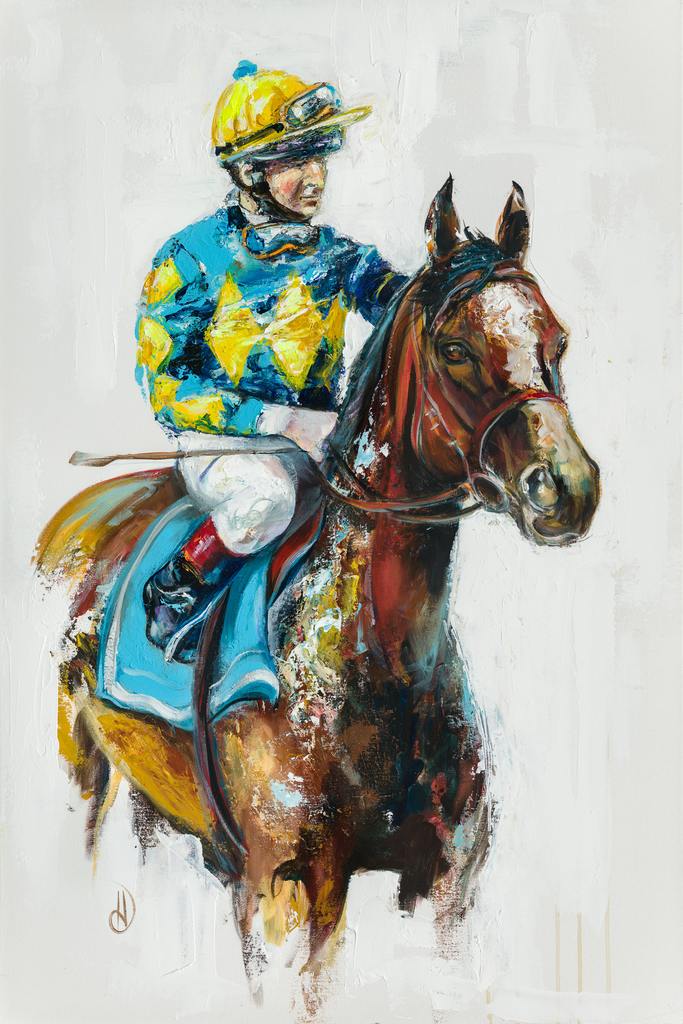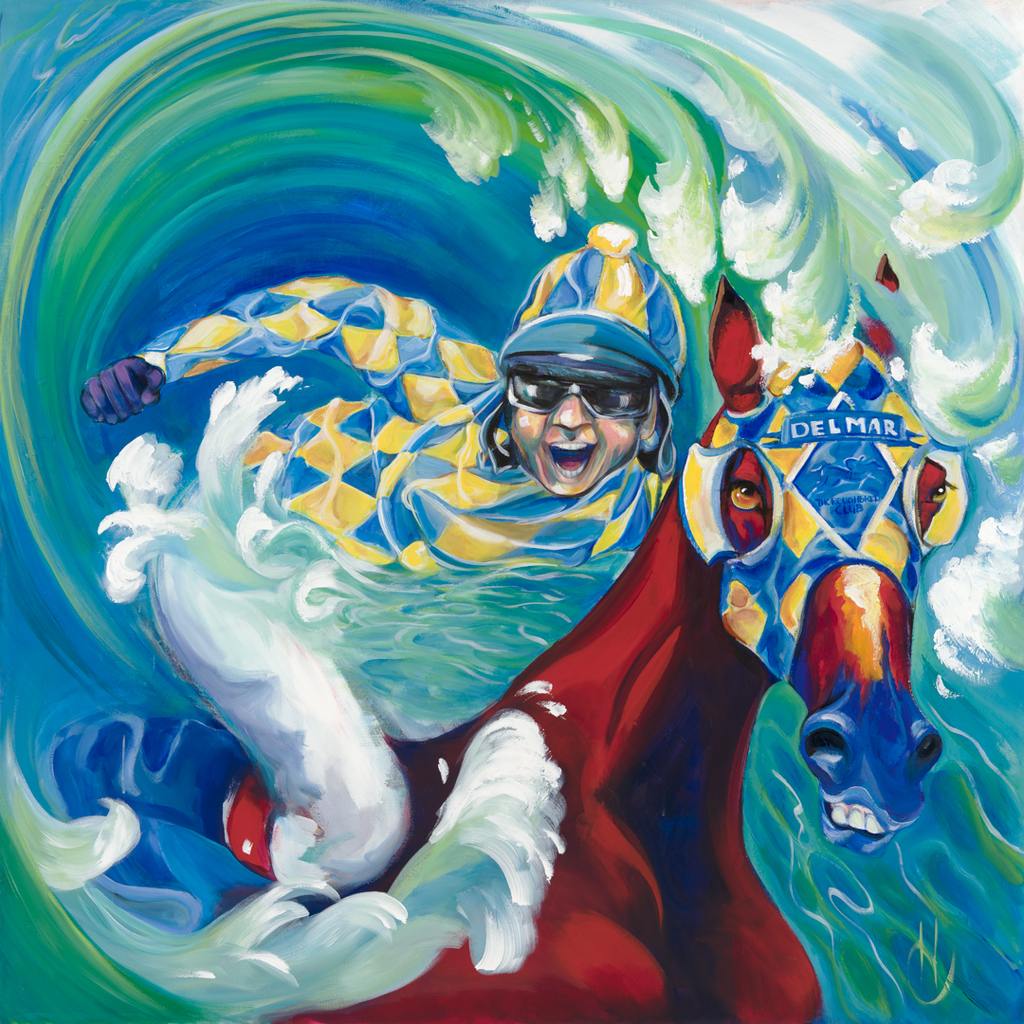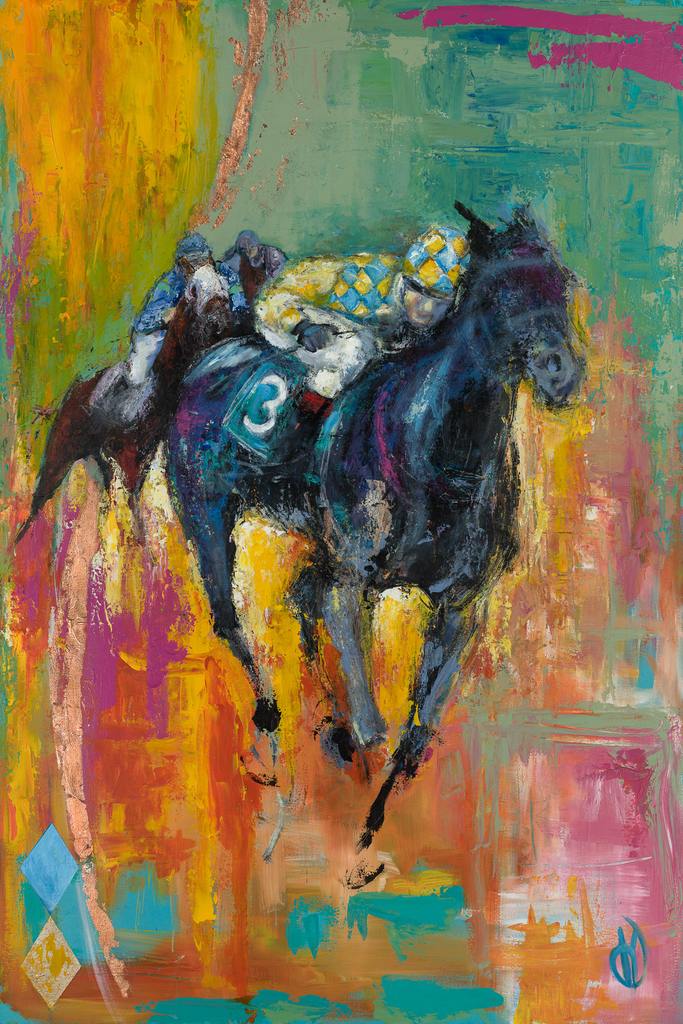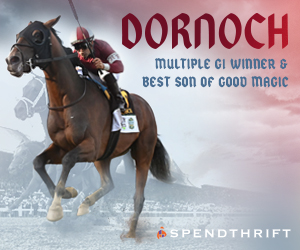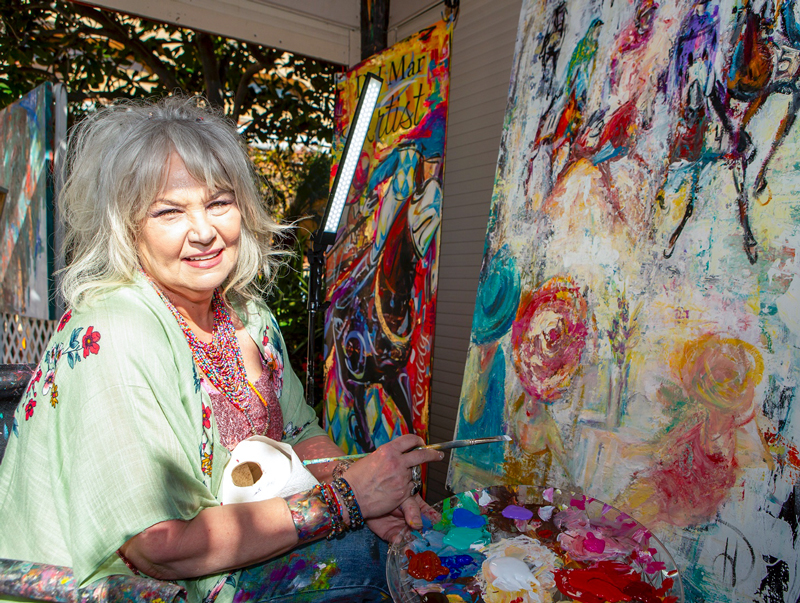
Heather Roddy. (Benoit Photo)
By Jim Charvat
There are many aspects to the Del Mar experience that makes it one of the most popular racetracks in America. There are the horses and the people but there is also the presentation. The beautiful setting, close to the Pacific Ocean nestled in a little valley surrounded by million-dollar homes and condos.
There is also the sea of color. The minute you walk through the turnstiles you are met with plants and flowers of every imaginable color. There’s the beautiful paddock area and the lush green turf course. There are also the thousands of pictures and paintings hanging on the walls of the grandstand. Some historical, others celebrating the horse. It is a feast for the eyes. Unforgettable for most who visit the seaside oval.
Heather Roddy has provided a fair bit of that color and many of the paintings you’ll find in the Turf Club and the clubhouse, in the luxury boxes and even on the covers of your program. Her unique style and use of bright colors stands apart from others.
Roddy’s association with Del Mar began several years ago when a patron to her gallery in the Flower Hill Mall suggested she enter one of her paintings in the “Program Cover Art Contest” held every year at Del Mar.
“People that went to the movies at night when we had theatres there (at Flower Hill) would walk around the mall even though everything was closed,” Roddy says. “But my gallery wasn’t closed, and I was in there painting racehorses. People would say ‘why aren’t you in Del Mar?’ So, I entered the program cover contest. This was eight years ago, and I’ve won it three times.”
Thus began a partnership that has led to several more contributions to the Del Mar landscape. Two of her paintings greet you when you enter the Turf Club.
“One of them I painted at the Hilton Hotel across the street from the track,” Roddy explains. “I forgot my (painting) knife so I went into the dining room, and I took the silverware. I tried the knife, but it didn’t have a bend in it, which I need. But the spoon worked, and I finished the painting with a spoon.”
Roddy seldom uses a brush when creating her paintings but instead uses a palette knife, a flat piece of metal with a handle that curves at the top. The handle of her personal favorite knife is caked in paint from years of use.
She began painting as a child and will proudly tell you that she’s self-taught, though she had a major influence in her home growing up. Her father is the famous oil painter Gary Jenkins.
“He used to be on television in the seventies and eighties,” Roddy says. “He was one of those guys who painted on PBS. He didn’t teach me how to paint. What he taught me was the work ethic. He was gone all the time, traveling and teaching all around the United States. We lived a good life off of his artwork.”
Roddy was born in San Diego in 1965.
“At Sharp (hospital),” she notes. “I’m kind of a coast baby. We moved around but stayed in Southern California. Laguna Beach, San Clemente. I went to high school in El Toro. When I started having babies, I wanted to come home and I raised my three kids in Poway.”
Her marriage ended in divorce, and she raised her three babies on her own. It was a precarious situation for a struggling artist. She was constantly badgered by family and friends to find other work.
“A real job. That’s what you’re told,” Roddy says. “But I believed in myself and my craft, this hunger. Nothing else can fill that bucket.”
As long as she was painting, she was happy and soon Roddy found a great way to make some extra cash and still paint. She took on jobs painting Christmas windows around San Diego.
“We were very strapped during the year, but my kids always had a really nice Christmas,” Roddy says. “I’d go to the shopping centers and car dealerships. The store owners would wait for me to show up. I’d take my kids in a stroller, one in a pouch and they would hold my babies while I did their windows.
“I would do caroling scenes and such,” she continues. “I started the day after Thanksgiving, and I would pawn my rings to get paint. I was 21. I’d do my first job and then go and get my rings back. I bartered cars with my artwork. It’s been a long journey.”
If you go to the Flower Hill Mall on Via de la Valle across the Fwy 5 from Del Mar, you can still see evidence of Roddy’s early beginnings.
“A gallery (in the mall) was representing me,” Roddy notes, “and I used to paint outside the gallery. I didn’t get paid; I was self-promoting. I painted in front of that gallery for three years. There’s still paint on the ground where I worked.”
Then one day she got her big break.
“Every day the owner (of the Flower Hill Mall) showed up I would tell him ‘One day I’m going to have a gallery here’,” Roddy remembers. “One year he stopped and told me to go check out a certain space in the mall. There was a key by the window and he said ‘when can you get in there?’ It was a beautiful space.”
In addition to exhibiting and selling her paintings in the gallery, Roddy taught classes there to help pay the rent.
“I’m a night painter,” she says. “I start at 3 p.m. and sometimes paint through the night.”
Roddy’s paintings are not limited to horses, though that’s her favorite subject.
“I paint everything,” she says. “I never say ‘no.’ I’m self-taught and if somebody says ‘Hey, great stuff can you paint a da da da,’ you say ‘Yes I can’ and then you go learn how to do it. We didn’t have the Internet, so I went to the library and looked up photographs of whatever, a lady in a boat, a floral. I’d figure it out. I figured out so much that I can paint everything and anything. All kinds of subjects.”
But it was her paintings of horses that caught the attention of Del Mar, a place she’s been a fan of all her life.
“A lot of people don’t get it,” Roddy insists. “This is the Del Mar racetrack; this is a big deal to those of us from the area. There’s the history. It’s a shame a lot of transplants don’t get it. I have a lot of pride in Del Mar because we take care of our horses and that means a lot to me.
“When they walk them by, going into the paddock, I go and stare at them,” Roddy continues. “They’re incredible, gentle beasts. I can’t soak up enough.”
Like a well-groomed racehorse, Roddy’s paintings are also big and beautiful. She can be found most race days at her stand off the clubhouse entrance next to the small fountain. There you’ll find samplings of her work, all of which are on sale. More times than not you’ll find her working on a new painting, The first thing that jumps out at you when you see one of her creations is the size.
“People tell me to paint smaller stuff, but they don’t sell,” she says. “People like the big paintings. If I want to express something, it doesn’t matter how big it is. Sometimes my paintings are five-by-seven and we’re talking feet. I honestly can’t help it.”
You’ll also note, when standing in front of one of her paintings, that these are not portraits of horses. The horses in the picture are not anatomically correct.
“That’s not what I’m after. I didn’t grow up with horses. I can’t explain it but I will tell you I’m after a feeling when I paint them. I don’t have any control over it. I’m thinking about other things like, what I need to get done. I love to paint women but not portraits. That bores me. I can’t do it. Things like that I’ve always been off the grid.”
Roddy doesn’t put dabs of paint on the canvas with a brush, she takes her painting knife and applies layers of paint and then scratches at it.
“There’s presence underneath, there’s color because of what’s dried underneath,” Roddy explains. “When I put wet paint on top, whatever I scratch at makes the bottom color come up. That’s why there’s tons of color in there because each scratch shows a color.”
And the more you stare at one of her paintings, the more you see. It’s that phenomenon that makes Roddy’s paintings so unique…and popular.
“One painting looks like flowers,” she says. “But if you look closer, there’s faces of ladies and as you stay in the painting and move around you see there’s people down there. But there’s no plan. That’s why nothing is the same. I start and it goes in a direction.”
Arguably her most beautiful and intriguing painting is mounted on the wall on the first level of the Del Mar grandstand as you walk into the Stretch Run area. It was a painting she was commissioned by Del Mar to paint on Opening Day 2018. She was asked to go to the west end of the blacktop and paint what she saw.
There were women in their fancy hats, the horses on the track and the thousands of people having a good time while playing the ponies. Painted entirely with the knife, Roddy solicited contributions from track patrons. As people walked up, she handed them the knife.
“I do it with kids,” Roddy says. “I ask them what’s your favorite color? ‘Blue’.”
She puts a dab of blue on the knife and points them toward the canvas. The kids go right up and slap it on, but Roddy says when she asks adults they hesitate. They tell her they’re afraid they’ll mess up the painting. She assures them that’s not possible.
Prior to that day in 2018, Del Mar asked Roddy to submit a design of what she was going to paint, and she did but later called and asked if she could get out of it because she couldn’t guarantee that it would turn out like her design.
“I wanted the diamonds and the energy and the color but didn’t want to be held to someone sitting a certain way,” Roddy explains. “All of that is grid and mechanics and it would have no life. People would just walk right by it and not even notice it. But because it’s spontaneous it’s fun and alive. It was hot on that day, but I’d do it again. I enjoyed it a lot.”
Roddy is 58 years old now. She had her first showing when she was 19 but retirement is the furthest thing from her mind, noting that artists never retire. Her father is still painting well into his eighties.
“I’m telling you it’s a privilege to be here right now to be able to do this,” she says. “I have to tell you what an honor it is that I get to hang my paintings in the Turf Club. I don’t take that lightly. Something like this isn’t just handed to somebody. You have to pay your dues and I’m grateful.”



